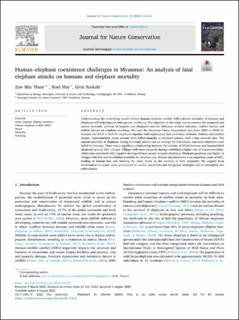Human–elephant coexistence challenges in Myanmar: An analysis of fatal elephant attacks on humans and elephant mortality
Peer reviewed, Journal article
Published version

View/
Date
2022Metadata
Show full item recordCollections
- Publikasjoner fra CRIStin - NINA [2364]
- Scientific publications [1392]
Original version
10.1016/j.jnc.2022.126260Abstract
Understanding the underlying causes behind human–elephant conflict (HEC)-driven mortality of humans and elephants will help improve both parties’ wellbeing. The objective of this study was to examine the temporal and spatial mortality patterns of humans and elephants and the influence of local attitudes, conflict factors and habitat factors on elephant poaching. We used the Myanmar Forest Department data from 2001 to 2020 for humans and 2011 to 2020 for elephants together with explanatory data on human attitudes, habitat, and conflict factors. Approximately seven persons were killed annually in elephant attacks, with a bias towards men. The annual mortality of elephants during the study period was on average 16 individuals, and most elephants were killed by humans. There was a significant relationship between the number of killed humans and human-killed elephants around HEC villages. Villages with more property damage exhibited a higher rate of human mortality, which also correlated with negative feelings of local people towards elephants. Elephant poaching was higher in villages with less suitable habitat available for elephant use. Human encroachment is an important cause of HEC, leading to human loss and forming the main threat to the survival of wild elephants. We suggest local involvement to ensure good governance in conflict resolution and mitigation strategies and to strengthen law enforcement. Asian elephant (Elephas maximus) Human–elephant conflict (HEC) Attack Mortality Poaching
Journal
Journal for Nature ConservationCopyright
© 2022 The AuthorsRelated items
Showing items related by title, author, creator and subject.
-
Effect of human–elephant conflict on local attitudes toward the conservation of wild Asian elephants in Myanmar
Thant, Zaw Min; May, Roelof Frans; Røskaft, Eivin (Peer reviewed; Journal article, 2022)The study of attitudes toward wild elephants and human–elephant conflict (HEC) is vital to understanding what attitudes are held by local people and how to incorporate them into wild elephant conservation. This study ... -
Elephants over the Cliff: Explaining Wildlife Killings in Tanzania
Mariki, Sayuni; Svarstad, Hanne; Benjaminsen, Tor A (Journal article; Peer reviewed, 2014)Many incidents of elephant killings have recently taken place in Tanzania as well as in other Africancountries. Such events are usually presented as results of the rising global demand for ivory. As we showin this case ... -
Being stressed outside the park — conservation of African elephants (Loxodonta africana) in Namibia
Hunninck, Louis; Ringstad, Iris; Jackson, Craig Ryan; May, Roelof Frans; Fossøy, Frode; Uiseb, Kenneth; Killian, Werner; Røskaft, Eivin (Journal article; Peer reviewed, 2017)The conservation of the African savanna elephant (Loxodonta africana) is of prime importance for many African countries. Interactions between elephants and humans are known to induce stress and thereby have the potential ...
